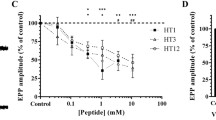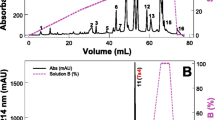Abstract
This study describes the isolation of a 11 kDa paralysis toxin from crude larval extracts of Argas (Persicargas) walkerae by exploiting the cross-reactivity of a monoclonal antibody (4B12), directed against the paralysis toxin of Rhipicephalus evertsi evertsi. This low molecular mass is in contrast to previous findings of a 60–70 kDa toxin for A. (P.) walkerae but is similar to neurotoxins isolated from venomous forms of the class Arachnida, which comprise the orders Araneae (spiders), Scorpionida (Scorpions) and Acari (ticks and mites). Since numerous antigenic bands, ranging between 11 and 115 kDa, were detected by the monoclonal antibody 4B12, the possibility of toxin-complex formation and the effect of pH on the latter were investigated by means of HPLC and ammonium sulphate precipitation. The results suggest that physiological conditions, with respect to pH and ionic strength, promote the formation of heterogeneous toxin-complexes while an acidic pH favours the formation of a more homogeneous toxin-containing complex. Furthermore, the effect of partially purified toxin on neurotransmitter release from crude rat brain synaptosomes was investigated, since tick paralysis toxins are hypothesised to inhibit neurotransmitter release from the presynaptic terminal. Both calcium-dependent, as well as calcium-independent release was inhibited by the toxin-containing sample.
Similar content being viewed by others
References
Bartlett, S.E. and Smith, M.T. 1996. Effects of morphine-3-glucuronide and morphine on the K+-evoked release of [3H]-glutamic acid and [14C]-Gamma-aminobutyric acid from rat brain synaptosomes. Life Sci. 58: 447–454.
Bettini, S. 1978. Handbook of Experimental Pharmacology, volume 4. Arthropod Venoms. Springer-Verlag, Berlin, New York.
Chicheportiche, R. and Lazdunski, M. 1970. The conformation of small proteins. The statediagram of a neurotoxin of Androctonus Australis Hector. Eur. J. Biochem. 14: 549–555.
Crause, J.C. 1993. Biochemical characterization of the paralysis toxin of Rhipicephalus evertsi evertsi. PhD Thesis, Faculty of Science, Department of Biochemistry, University of Pretoria.
Crause, J.C., van Wyngaardt, S., Gothe, R. and Neitz, A.W.H. 1994. A shared epitope found in the major paralysis inducing tick species of Africa. Exp. Appl. Acarol. 18: 51–59.
Goldring, J.P.D. and Ravaioli, L. 1996. Solubilization of protein-dye complexes on nitrocellulose to quantify proteins spectrophotometrically. Anal. Biochem. 242: 197–201.
Gothe, R. and Koop, E. 1974. Zur biologischen Bewertung der validität von Argas (Persicargas) persicus (Oken, 1818), Argas (Persicargas) arboreus (Kaiser, Hoogstraal and Kohls, 1964) and Argas (Persicargas) walkera (Kaiser and Hoogstraal, 1969) II Kreuzumgsversuche Z. Parasitenkd. 44: 319–328.
Gothe, R. and Neitz, A.W.H. 1991. Tick paralyses: Pathogenesis and etiology. In: Advances in disease vector research, Harris, K.F. (ed.). Springer-Verlag New York Inc, vol. 8, pp. 177–203.
Gothe, R. 1999. Zecken toxikosen, Hieronymns, Munich.
Laemmli, U.K. 1970. Cleavage of structural proteins during the assembly of the head of bacteriophage T4. Nature 227: 680–685.
Massina, S., Lopresti, C. and Broady, K.W. 1999. Sequence determination, expression and purification of an Australian paralysis tick neurotoxin. 24th Lorne Protein Conference, Lorne, Victoria, Australia.
Mulder, A.H., van den Berg, W.B. and Stoof, J.C. 1975. Calcium-dependent release of radiolabeled catecholamines and seretonin from rat brain synaptosomes in a superfusion system. Brain. Res. 99: 419–424.
Schägger, G. and von Jagow, G. 1987. Tricine–sodium dodecyl sulfate–polyacrylamide gel electrophoresis for the separation of proteins in the range from 1 to 100 kDa. Anal. Biochem. 16(6): 368–379.
Stone, B.F. and Binnington, K.C. 1986. The paralyzing toxin and other immunogens of the tick Ixodes holocyclus and the role of the salivary gland in their biosynthesis. In: Morphology, Physiology and Behavioral Biology of Ticks, Sauer, J.R. and Hair, J.A. (eds). Ellis Horwood, Chichester.
Viljoen, G.J., Bezuidenhout, J.D., Oberem, P.T., Vermeulen, N.M.J., Visser, L., Gothe, R. and Neitz, A.W.H. 1986. Isolation of a neurotoxin from the salivary glands of female Rhipicephalus everti evertsi. J. Parasitol. 72: 865–874.
Viljoen, G.J., van Wyngaardt, S., Gothe, R., Visser, L., Bezuidenhout, J.D. and Neitz, A.W.H. 1990. The detection and isolation of a paralysis toxin present in Argas (Persicargas) walkerae. Onderstepoort J. Vet. Res. 57: 163–168.
Author information
Authors and Affiliations
Rights and permissions
About this article
Cite this article
Maritz, C., Louw, A., Gothe, R. et al. Detection and micro-scale isolation of a low molecular mass paralysis toxin from the tick, Argas (Persicargas) walkerae. Exp Appl Acarol 24, 615–630 (2000). https://doi.org/10.1023/A:1026565222030
Issue Date:
DOI: https://doi.org/10.1023/A:1026565222030




